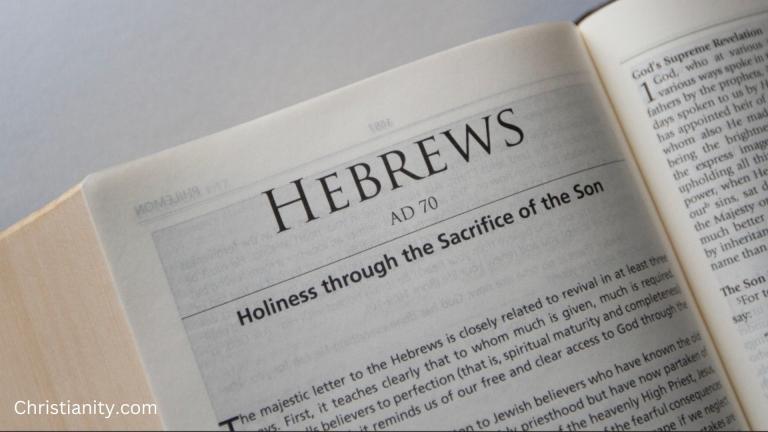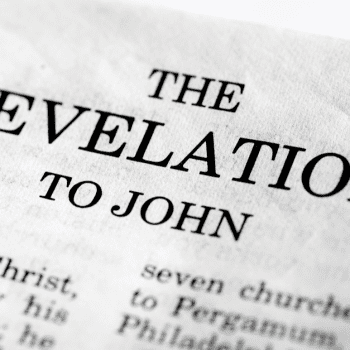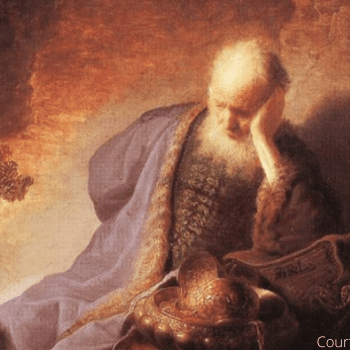Monday: Read Hebrews 9:1-10
Hebrews 9 begins what may come across as boring and irrelevant. What the author says at the opening of this chapter, however, leads to the discussion of the person and work of Christ at the end of the chapter.
The primary focus of this chapter is a contrast between the old covenant and the new. The author begins by noting two features of the old covenant: “regulations of divine worship and the earthly sanctuary” (1). The author then treats them in reverse order.
The author’s main point is that these features were ultimately a hindrance to relating to God. Thus, though it may appear that the author is simply describing the temple and the priests’ duties in the temple, as we will see, he/she has a clear objective in view: namely, to demonstrate the superiority of Christ.
In 9:2-5, the author details the items in the temple. Then 9:6-10 describes the priests and their duties.
Several weaknesses in the temple system become evident in 9:7. First, only the high priest could enter the inner sanctuary and the presence of God (7). Second, the high priest could only enter once a year (7). Third, the high priest could only enter with blood (7). Fourth, the high priest needed to bring blood for himself AND for the people (7).
The evidence that this sufficient was insufficient is summarized: “both gifts and sacrifices are offered which cannot make the worshiper perfect in conscience” (9).
Questions to ponder/discuss:
- One should not read this passage and the larger section within which it lies (5:11-10:39) and conclude that the OT temple, sacrifices, and priests were meaningless. Nor should we look upon the Jewish people as inferior. As we will see in 11:1-12:1 many of them were the heroes of the faith and serve today as a “great cloud of witnesses” (12:1) for us. If anything, we should be humbled even more so by the cross and the sacrifice of Christ.
- The OT sacrifices and their priests did serve a purpose. Part of that purpose was to point us to Christ. As you ponder the cross and the sacrifice of Christ, discuss what the cross means for you. Then discuss how you will aim to live differently in light of the cross.
Tuesday: Read Hebrews 9:11-28
By way of contrast with the old covenant and its temple and priests, the author now turns to Christ (11). This section contrasts the Jerusalem temple and its worship and turns to the uncreated heavenly sanctuary and the worship in it.
The author first notes that Jesus appeared “as a high priest” (11) and “He entered through the greater and more perfect tabernacle, not made with hands” (11). To be “not made with hands” means that it was divinely made.
The author continues by noting that Jesus entered not with the blood of animals but “through His own blood” (12). And, the author adds, He “entered the holy place once for all, having obtained eternal redemption” (12).
The author then expounds on the nature of covenants. Namely, a covenant requires blood (16). So, also, Jesus entered the tabernacle with blood. But the tabernacle He entered was “into heaven itself” (24) and “in the presence of God for us” (24). Jesus not only entered the heavenly tabernacle, but in contrast to the high priest, He did so with His own blood (25), which resulted in a “better” sacrifice (23).
Because Jesus offered His own blood, He only needed one sacrifice (26). After all, just as we die once and then face judgment (27), so also Christ offered Himself once (28). Christ, of course, “will appear a second time for salvation without reference to sin, to those who eagerly await Him” (28).
Questions to ponder/discuss:
- We must be very careful not to read Hebrews (or any part of the Bible for that matter) from our western, dualistic perspective. That is, when the author says that Jesus entered “the greater and more perfect tabernacle, not made with hands, that is to say, not of this creation” (11), he/she is not referring to a spiritual temple in heaven. Instead, it is of an entirely different kind. It is not of this creation! Of course, we think of this world stuff simply because we know of nothing else (that is because there is nothing else; except God). As a result, we always minimize the grandeur of God. Spend some time in prayer reflecting on the grandeur and transcendence of God. This might require you (and no this is not eastern mysticism) to focus on nothing but God.
Wednesday: Read Hebrews 10:1-18; Psalm 40:6-8
The author continues to explain the benefit of the new covenant and the weakness of the old.
One of the weaknesses of the old covenant is exemplified in the fact that the priests have to offer sacrifices “time after time” (11). They continue to offer them over and over because they cannot “make perfect those who draw near” (1). The problem is that “it is impossible for the blood of bulls and goats to take away sins” (4, 11).
Because the sacrifices cannot take away sins, the priests have to continuously offer sacrifices: “Every priest stands daily ministering and offering time after time the same sacrifices, which can never take away sins” (11).
At the same time, it is important to note, as the citation of Psalm 40 makes clear, God does not desire “sacrifice and offering” (5, 8). Instead, He desires that we do His will (7, 9).
All of this contrasts with the finished work of Christ: “He has perfected for all time those who are sanctified” (14). This prompts the author to cite the new covenant in Jer 31:31-34 (16-17).
The author concludes by noting that because Christ’s sacrifice was complete, there is no longer any need for sacrifices (18).[2]
Questions to ponder/discuss:
- Note that the OT priests were never permitted to sit (11). This testifies that their work was never finished. Jesus, however, “sat down” (12; see also: 1:3; 12:2; Rev 3:9). This is why He utters on the cross, “it is finished” (John 19:30).
- It is important to note that the NT teaching of the cross and the sacrifice of Christ does not end with Christ’s sacrifice. Of course, the forgiveness of sins and the making of atonement has been made complete in Christ. The NT, however, as we noted in Rom 12:1-2, now urges us to follow in the way of Christ and to “present your bodies a living and holy sacrifice, acceptable to God.” What does presenting ourselves as a sacrifice look like?
Thursday: Read Hebrews 10:19-39
The author brings to completion the long theological argument that began in 5:11. There is some repetition here because the author is bringing the argument to a close by reiterating some of the key points.
The author focuses on the importance of faithful living as a result of the truths that have been presented. Thus, “since we have confidence to enter the holy place by the blood of Jesus . . . let us draw near with a sincere heart in full assurance of faith” (19, 22).
Furthermore, these truths should encourage us to “hold fast the confession of our hope without wavering” (23). And more than that, we should also “consider how to stimulate one another to love and good deeds” (24).
The author then includes another stern warning, which parallels the warning of 6:4-6, regarding those who fall away (26-31). The argument is that if those who fell away under the old covenant experienced God’s judgment, “how much severer” will the punishment be for those trampled “under foot the Son of God”? (29).
Questions to ponder/discuss:
- There has been much debate regarding 10:26-31. One of the keys to understanding it is to recognize that the author is referring to deliberate acts of continuous sin. In saying this, we must be careful about minimizing the force of this passage.
- We all experience highs and lows in our faith. The goal is certainly to experience more highs and even continuous growth. But we all experience lows for a variety of reasons. This is why the exhortation of 10:24 is so important, “and let us consider how to stimulate one another to love and good deeds.” Spend some time in prayer and ask the Lord for wisdom on how to be an encourager for others so that we might all work towards “love and good deeds.”
Friday: Read Hebrews 11:1-12:3
Hebrews 11 develops the themes of faith and endurance. The author uses the examples of persons of faith in order to encourage his/her audience to persevere.
The author begins the famed “faith” chapter with a brief definition of faith. The author notes that faith is based on the confidence in God’s promises with regard to what is future (“the assurance of things hoped for”; 1) and what is not seen (1). This does not make faith “blind” as have some asserted. The ultimate “unseen” is God Himself.
Thus, biblical faith is a confident trust in God that He will carry forth what He has promised. That faith is not a blind trust is evident in that the essence of this whole chapter is a catalog of God’s acts through His people. That is, this chapter is not simply a list of men and women who have had faith. It is also a list of those through whom God has done mighty deeds as a result of their faith.
For the author of Hebrews, the understanding that creation is the result of God’s command is foundational to his/her conception of faith (3).
One commentator concluded this about faith in the book of Hebrews: “Hebrews shows the link between faith, hope, obedience and endurance, illustrating that it is more than intellectual assent to certain beliefs. God-honouring faith takes God at his word and lives expectantly and obediently in the present, waiting for him to fulfil his promises.”[3]
Questions to ponder/discuss:
- One of the beautiful aspects of this chapter is that there are some people on this list that make us wonder, “what are they doing here?” This should serve as encouragement for us. After all, if they can make the list, then maybe so can we.
- Ultimately, we are to fix “our eyes on Jesus” (12:2). But this doesn’t mean, as Hebrews 11 affirms, that we cannot look to the faith of others and gain inspiration, hope, and encouragement. Discuss some individuals that you have gained inspiration, hope, or encouragement from.
- Do you have people you can turn to when things get tough? If not, reach out to your church and express your desire to have a mentor in your life.
- If you are not a mentor to someone else, contact your church and find out what the process is so that you may become a mentor.
[1] This guide is meant to be done either as a group study over the course of 2 or 4 meetings (Day 1-5; 6-10; 11-15; 16-20), or as a private devotion over the course of 4 weeks (or a calendar month—5 lessons per week).
[2] NB: some suggest that a third temple will be rebuilt in Jerusalem and the Jews will reinstitute the sacrificial system. Even if this were to take place, the book of Hebrews is clear, they would have no ability to forgive sins.
[3] Peterson, D. G. (1994). Hebrews. In D. A. Carson, R. T. France, J. A. Motyer, & G. J. Wenham (Eds.), New Bible commentary: 21st century edition (4th ed., p. 1345). Leicester, England; Downers Grove, IL: Inter-Varsity Press.











